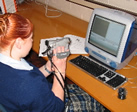Primary 6
This lesson was planned to introduce a one-term discrete study unit on Christianity.
The Professional Council for Religious Education (PCfRE)offers an online interactive database resource ‘Listening to children talking’, which provides children's responses to a range of religious and spiritual questions. It is possible to search the database by age, gender and religious affiliation. When pupils were asked to investigate the beliefs of Christian pupils their age, they were able to identify themes and patterns of belief, alongside considering their own beliefs and how they affect the way they live.
The teacher introduced pupils to the learning intention and success criterion for the lesson:
learning intention: To know some answers that Christians would give to the big question, 'What is God like?'
success criterion: You will be explaining what you have found out about Christian beliefs in God.
The question ‘What is God like?’ was put on the whiteboard and pupils were invited to discuss their ideas in pairs. After time to think, talk and share, the question was put in the middle of a piece of paper and pupils mind-mapped their ideas, adding any branches to which they could assign specifically religious answers. Pupils were given 20 minutes to complete this.
Attention was then focused on the interactive whiteboard. However, the equipment was not used interactively: a data projector, or an accessible monitor that pupils could gather around, would have been just as effective. The online interactive database 'Listening to children talking' was shown and the various possibilities were demonstrated. Pupils were shown how to refine a search both by question and by respondent.
Their task was to investigate how Christian pupils their age had responded to the question ‘What is God like?’. They were to examine the answers in the database to identify common themes, words or statements that showed how Christians responded to the question. They copied and pasted the statements that they felt were most representative of a Christian response and were shown how to access a word-processed document that had been saved. The document had a space at the top for pupils to type their name, a hotlink to the first page they needed to access, and the full question to which children had responded. It also contained a summary of the task.
Pupils were given 20 minutes to interrogate the database, using a cluster of computers adjacent to the classroom. They worked in pairs that were mixed in literacy ability in order to support the reading. Some also used the regularly practised technique of copying and pasting into Textease and using the speech tool to hear the text.
Soon, various words were clearly repeating themselves and pupils began to identify patterns. Almost more importantly, they spotted exceptions. One pupil asked how a person could call themselves a Christian when they said they didn’t believe in God. With five minutes to go, pupils were asked to select some key statements, copy and paste them, and save and print the documents.
Back in the classroom, pupils were given time to talk and share. Words that pupils felt had been recurring in their investigation were then added to the mind map. They added questions of their own.
As a plenary, pupils were asked to form groups of four and share their work with each other. Pupils were given the sentence starter ‘After looking at this today, I think Christians believe…’ and asked to discuss how they would finish it. This was then recorded on their work.
Finally, pupils were given paper copies of the primary questionnaire that forms the basis of the database. It was explained that all the answers they read had begun like this and that if they wanted to, they could add their own answers to the database, so that others could look at their answers and think of their own. It was offered to them as homework for those who chose to. More than half the class returned the questionnaire and entered their details on the database.
The written outcomes of the lesson provided an insight into pupils’ ways of thinking and ability to formulate questions. Much more importantly though, it gave pupils permission to have opinions, share beliefs and ask big questions. It set the context for the study unit and ensured that the focus of all teaching and learning for the term was not stories and events, but belief and its impact on the life of believers.
This activity provided opportunity for pupils to:
know some answers that Christians give to the big question ‘What is God like?’ (attainment target 1, level 2)
respond to what Christians say with their own ideas and questions in answer to the ‘big question’ (attainment target 2, level 2).
How ICT enhanced teaching and learning
Ways ICT has helped pupils:
ICT enabled pupils to access and respond to the authentic comments of a wide range of young people of their choice, across a range of criteria (religious affiliation, gender, age and topic,for example).
Pupils were able to search a vast amount of data and to find the data most useful for the particular task. The ICT solution is much more effective and efficient than an equivalent paper-based system.
The database is a moderated resource to which the pupils added their own views and opinions in response to the original question. This provided an incentive for them to be respectful of the comments they were interpreting and reflective in terms of considering their own thoughts for inclusion.
Related Resources on the Becta website

